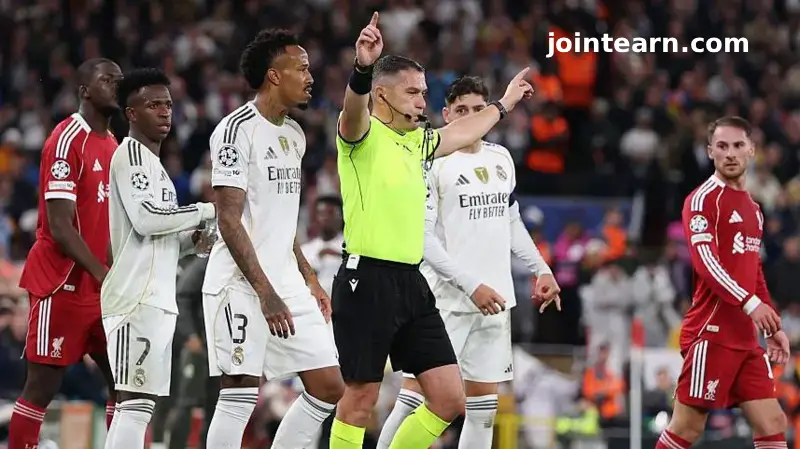
Referee Istvan Kovacs overturns potential penalty after VAR review on Aurelien Tchouameni incident
Football fans were once again left scratching their heads after a dramatic VAR intervention during Liverpool’s Champions League clash with Real Madrid. A seemingly straightforward free-kick call turned into a drop ball to Real Madrid goalkeeper Thibaut Courtois — leaving supporters baffled and frustrated.
How Liverpool’s Free-Kick Became a Drop Ball
In the 30th minute, Liverpool’s Dominik Szoboszlai unleashed a shot that struck Real Madrid’s Aurelien Tchouameni. Referee Istvan Kovacs initially blew for handball, awarding Liverpool a free-kick just outside the penalty area — a decision that looked dangerously close to being inside the box.
VAR official Bastian Dankert immediately reviewed the footage. When Kovacs was called over to the pitchside monitor, the Anfield crowd erupted, believing a penalty was on the way. However, the review had an entirely different purpose.
A referee is only sent to the monitor to re-evaluate subjective decisions — such as whether a handball offence actually occurred — not to determine factual matters like where it took place. Since Kovacs went to the screen, it meant the VAR had already ruled that the handball was inside the penalty area, and the referee was being asked to decide if it was indeed a handball at all.
After review, Kovacs overturned his original call. The footage showed Tchouameni’s arm was close to his body and not creating an unnatural barrier — meaning no offence had been committed. As a result, instead of a free-kick or penalty, play restarted with a drop ball to Courtois, effectively handing Real Madrid back possession and ending Liverpool’s attack.
For fans hoping for a penalty, cheers quickly turned into disbelief. Still, the decision was technically correct under UEFA’s VAR protocols.
Arsenal Benefit from VAR Handball Call
Over in Prague, Arsenal found themselves on the right side of VAR luck in their 32nd-minute penalty against Slavia Prague. Defender Lukas Provod appeared to handle the ball in the box after a corner, but replays showed it deflected off his head first.
So why was it still given? The key lies in the level of contact. If a player intentionally heads the ball into their own arm, a penalty is rarely awarded. But if it’s a slight or accidental deflection and the arm is raised above shoulder height, officials in European competitions tend to consider it an unnatural position — and that usually means a penalty.
While Premier League referees might have waved play on, UEFA’s stricter interpretation of handball meant Arsenal benefited this time.
Was Brennan Johnson’s Red Card Harsh?
Tottenham Hotspur’s Brennan Johnson also found himself at the center of VAR controversy in their match against FC Copenhagen. The forward was sent off in the 57th minute after a review upgraded his yellow card to red.
Johnson’s high challenge on Marcos Lopez appeared unintentional — his boot rose after missing the ball and caught Lopez on the back of the leg. But UEFA referees typically take a hard stance on any contact involving a straight leg and studs showing, regardless of intent.
Though the decision felt severe, under current interpretations, VAR deemed it a “clear and obvious” error to have shown only a yellow.
Champions League Continues to Test VAR Clarity
Once again, Europe’s elite competition showcased just how complex and divisive VAR can be. From overturned penalties to dropped balls and red-card debates, Tuesday night’s action reminded fans that while technology aims to bring fairness, it can often deliver confusion instead.


Leave a Reply